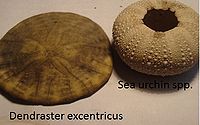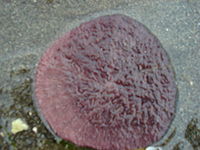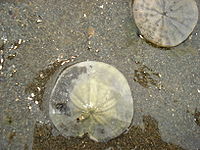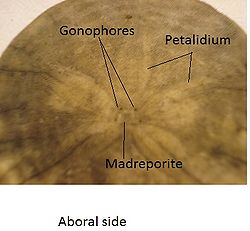Dendraster excentricus
From ize2010
Eccentric sand dollar (Dendraster excentricus), also known as the western sand dollar, or Pacific sand dollar, is a member of the order Clypeasteroida, better known as sand dollars.This information is also on Wikipedia under "Dendraster excentricus".
| Eccentric sand dollar | |
|---|---|
 |
|
| Dendraster excentricus on Burfoot beach, Olympia,WA. | |
| Scientific classification | |
| Kingdom: | Animalia |
| Phylum: | Echinodermata |
| Class: | Echinoidea |
| Order: | Clyeasteroida |
| Suborder: | Scutellina |
| Family: | Dendrasteridae |
| Genus: | Dendraster |
| Species: | D. excentricus |
| Binomial name | |
| Dendraster excentricus Eschscholtz, 1831 |
|
| Synonyms | |
|
Echinarachnius excentricus |
|
Contents |
General information
Dendraster excentricus is an irregular echinoid that is flattened and burrows into the sand, unlike the regular echinoids,or sea urchins.It can be found living in the Pacific Ocean from Alaska to Baja California[1.].The range for Dendraster excentricus is larger and includes the range of the other two extant species of Dendraster: D. vizcainoensis and D. terminalis.The flower pattern in this species is off-center,giving it the name excentricus[2.].A comparison of a Dendraster test with that of a sea urchin is seen below.

Taxonomy and Evolution
They are Echinoids meaning closely related to sea urchins,heart urchins and sand biscuits. Other Echinoderms include Sea stars and sea lilles, with whom they share some common features. Members of the Class Echinoidia first appeared in the Ordovician period (the second period of the Paleozoic era).After the Permo-Triassic the Miocidaris were the only remaining genus of Echinoids and diversified drastically. The two different types of Echinoids,the Cidaroids and Euechinoids, emerged and irregular echinoids emerged from the euchinoids in the early Jurassic. The Genus Dendraster originated in the northwestern Pacific in the Pliocene and may have evolved from the Echinarachniidae. Another theory suggests Dendraster came from the melidids because of their tooth structure.Smith (1984) gives a complete evolutionary history of the clypeasteroids [9.].
Description and Anatomy
They are colored gray, brown, black or shades of purple. Their size is variable but up to 100mm wide, and a dome shaped carapace varying in height to about 10mm, with a circular body or test. Their body is covered with fine, spiny tube-like feet with cilia, and unlike other echinoderms they have bilateral symmetry not radial.The mouth ,anus and food grooves are on the lower(oral) surface and the aboral surface has a petalidium, or petal shaped structure, with tube feet. Dead individuals have a gray/white test,or skeleton, which is often found washed up on beaches.It has a water-vascular system from the internal cavity or coelom that connect with tube feet. The tube feet are arranged in five paired rows and are found on the ambulacra – the five radial areas on the undersurface of the animal, and are used for locomotion, feeding, and respiration. Spines are generally club shaped in adults, and less so in juvenilles. The five ambulacral rows alternate with five interambulacral areas, where calcareous plates extend into the test.At the center on the aboral side is the madreporite - a perforated platelike structure, and on the interambulacra are the four tiny genital pores. Radiating out from the genital pores are the five flower petals, which represents the ambulacral radii. The mouth is in the center on the bottom side, with the anus toward the edge.
Habitat
They are either found subtidally in bays or open coastal areas or in the low intertidal zone on sandy on the Northeast Pacific coast[1.]. It can live at a depth of 40 to 90 meters, but usually is found in more shallow areas. Sand dollars are usually crowded together over an area half buried in the sand. As many as 625 sand dollars can live in one square yard (.85 sq m)[5.]. It is the only sand dollar found in Oregon and Washington. It has been found on Burfoot beach in the South Puget sound.
Behavior and Feeding
It is a suspension feeder which feeds on crustacean larvae, small copepods,diatoms,plankton and detritus. Adult sand dollars move mainly by waving their spines, while juveniles use their tube feet. The tube feet along the petalidium are larger and are used for respiration while tube feet elsewhere on the body are smaller and are used for feeding and locomotion. They frequently move around if they are lying flat. When feeding they usually lay at an angle with thier anterior end buried and catch small prey and algae with its pedicellariae, tube feet, and spines and pass them to the mouth. Their mouth includes a jaw, or Aristotle's lantern made of five structure's often called "doves". In high currents adults grow heavier skeletons while juveniles swallow heavy sand grains to keep from being swept away.They will bury themselves when they are being preyed on[3.].
Reproduction
The sexes are separate, with no noticable differences in external features of the two sexes[7.].Reproduction is sexual and D. excentricus reaches sexual maturity between 1 and 4 years of age, spawning in late spring and early summer[6.]. They will spawn many times in a lifetime. Fertilization is external,the female Dendraster discharges the eggs through her gonopores and they are fertilized by the male, who protrudes his genital papilla from his body wall.This is one reason they are believed to live in large groups and tend to release gametes at the same time into the water column.Eggs are pale orange,and covered by a thick jelly coat which keeps adults from eating the eggs.They go through several stages before they become an adult[8.].
Development
The first larval stage is called a prism. After this stage the embryo will develop two arms transforming itself into an echinopluteus larva. This is followed by the development of arms, until it reaches 8 arms all together.After this the larva develops into an echinus or juvenile rudiment,which will become the juvenile. The nektonic larvae are pelagic and travel away from the parent group with the current. The developed larvae will recieve a chemical cue from adults to settle down into a bed of sand dollars and begin to undergo metamorphosis to their adult sand dollar form. As adults they are benthos and stay on the sandy bottom in aggregations[8.].
Life Span and Predation
Predators include the seastar Pisaster brevispinus and the flounder Platichthys stellatus as well as crabs and sea gulls. They are sometimes settled on by a small barnacle Balanus pacificus. Large storms or high temperatures can cause mass mortality if it is very hot during low tide or if the animals are exposed to air for just 2 to 3 hours while washed up and buried in the sand. Old age is thought to be the main cause of death of Dendraster excentricus[3.]. They may live up to 13 years and can be aged by counting growth rings on the plates of the test or by counting the pores in a petal of the petalidium.
Conservation
The habitat they live in on the sandy seafloor is sometimes damaged by bottom trawling, causing harm to many organisms. Ocean acidification and sea surface warming are also harming populations of sand dollars.They are not considered endangered or threatened.[4].
References
- 1.Dendraster excentricus Intertidal Marine Invertebrates of the South Puget Sound
- 2.Dendraster excentricus Walla Walla
- 3.Biogeography of the Western Sand dollar San Francisco State University
- 4.Sand dollarMonterey Bay Aquarium
- 5.The persistance of a sand dollar
- 6.Strathrnann M. 1987. Reproduction and Development of Marine Invertebrates of the Northern Pacific Coast. University of Washington Press, Seattle, Washington.670pp.
- 7.Morris R.H., Abbott D.P., Haderlie E.G. 1992. Intertidal Invertebrates of California. Stanford University Press, Stanford, California.580 pp.
- 8.Marin Jarrin, Jose R. "Embriogenesis and Larval Stages of Dendraster excentricus". 2007.University of Oregon,Eugene,Oregon.
- 9.Smith, Andrew. "Echinoid Palaeobiology". 1984. London: George Allen & Unwin.
Further reading
- Rich Mooi."SAND DOLLARS OF THE GENUS DENDRASTER (ECHINOIDEA:CLYPEASTEROIDA): PHYLOGENETIC SYSTEMATICS,HETEROCHRONY, AND DISTRIBUTION OF EXTANT SPECIES".BULLETIN OF MARINE SCIENCE, 61(2): 343–375, 1997.





